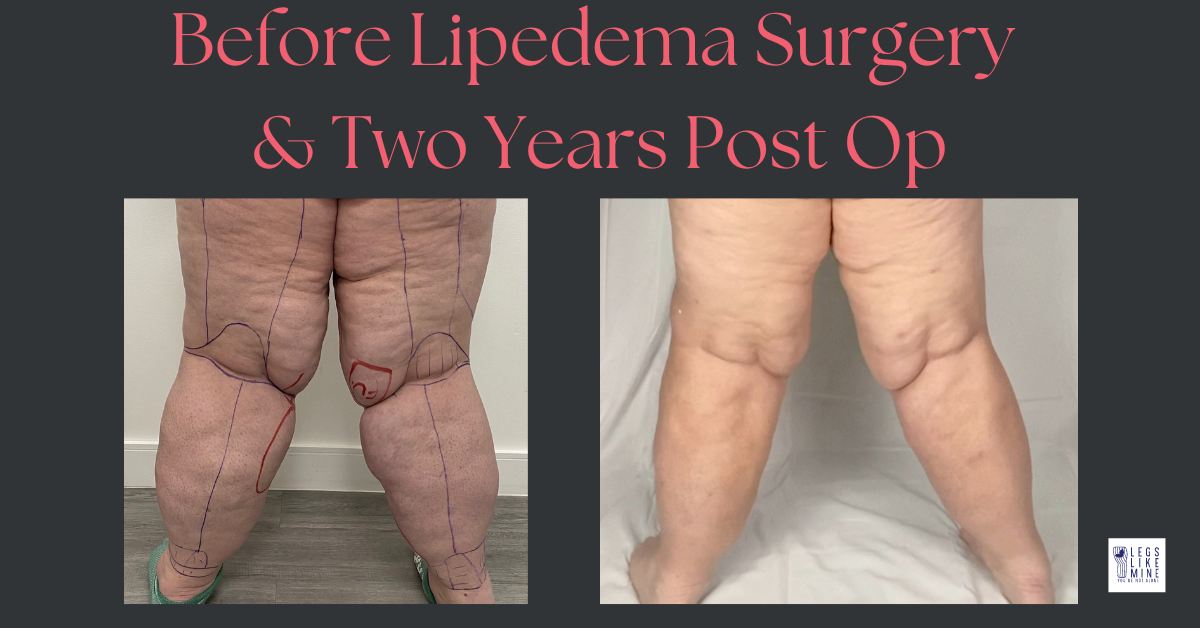Hi friends!
The holidays are amongst us, which means we’re eating all kinds of foods not in our normal diets, we’re probably experiencing some form of stress from shopping, money, family visits, and so on. And for a lot of us, the weather is changing. For me, I have more challenges when I’m in a hot or muggy environment, but believe it or not, some ladies have more challenges when the weather gets cold (go figure!). For those of us with lipedema, all of these things hit at once, and it also means we might be having flareups even when we normally have the condition in a state of calm.
What’s a Flareup?
Lipedema is a chronic condition that causes abnormal fat accumulation in the limbs, especially the legs. People with lipedema often experience pain, swelling, bruising, and reduced mobility. These symptoms can worsen during certain periods, such as hormonal changes, stress, infection, injury, or weather changes. These periods are known as flare-ups, and they can vary in frequency, duration, and severity. They look different in every single person. For me, I know stress and food are my biggest triggers and flareups can look like more pain during bedtime, to full-on, “my leg doubled in size” type situations. Flare-ups can be very frustrating and challenging to cope with, but there are some strategies that can help reduce their impact and improve your quality of life from experts and patients on how to manage lipedema flare-ups.
Tips and Tricks:
- Monitor your symptoms and triggers. Keeping a journal or using an app can help you track your symptoms, such as pain, swelling, stiffness, and skin changes. You can also note down any potential triggers, such as diet, exercise, medication, stress, or environmental factors. This can help you identify patterns and trends, and avoid or minimize the triggers that cause or worsen your flare-ups. This is how I figured out I needed a less stressful job, and I should probably stop drinking red wine.
- Seek medical advice and treatment. If you have not been diagnosed with lipedema, it is important to see a doctor who is familiar with the condition and can rule out other causes of your symptoms. If you have been diagnosed, you should follow your treatment plan and consult your doctor if you have any questions or concerns. Some of the treatments that can help with lipedema flare-ups include compression garments, manual lymphatic drainage, medications, and surgery.
- Watch for development of cellulitis. It’s really important to watch for the development of cellulitis with lipedema, and especially during a lipedema flare, as it can cause serious health problems if left untreated. Some signs and symptoms of cellulitis include:
Redness, warmth, and swelling in the affected areas
Fever, chills, and malaise
Blisters, pus, or skin breakdown
Enlarged or tender lymph nodes
If you notice any of these signs or symptoms, you should seek medical attention as soon as possible. Cellulitis can spread quickly and affect deeper tissues, such as the muscles, bones, or blood vessels. It can also cause sepsis, a life-threatening condition that occurs when the infection triggers a systemic inflammatory response.
- I also practice two things to help swelling get down quickly when I can’t get in a pool: Legs on the Wall and the Dead Cat Shake. Here’s a little Short about how to do legs on the wall. Check out my YouTube Channel for the Dead Cat Shake.
- Pay particular attention to what you’re eating during a flare. Eating a balanced diet (and this time of year, especially, it means really watching your sweets intake – it’s a killer for my legs) drinking plenty of water, getting enough sleep, and managing stress can help you maintain your overall health and well-being, and prevent or reduce inflammation and fluid retention. You should also avoid smoking, alcohol, caffeine, and processed foods during a flare, as they can aggravate your symptoms. Some supplements, such as omega-3 fatty acids, vitamin C, and turmeric, may also have anti-inflammatory and antioxidant benefits. (I actually take all of these items on the regular, but talk with your doctor before you take any supplements, OK?)
- Exercise regularly and gently (literally even if it’s ten minutes a day – MOVE). Physical activity can help you improve your blood circulation, lymphatic drainage, muscle strength, joint mobility, and mood. However, you should avoid exercises that are too strenuous, high-impact, or cause pain or injury. Instead, opt for low-impact, moderate-intensity exercises, such as walking, swimming (my personal favorite), cycling, yoga, or Pilates moves your body is comfortable doing (I do the ones NOT on the floor these days!). You can also do some stretching and breathing exercises to relax your muscles and mind. Always warm up before and cool down after exercising and wear comfortable and supportive clothing and shoes. If you’re out of the water, be absolutely sure to wear your compression during exercise.

- Seek support and self-care. Living with lipedema can be emotionally and mentally draining, especially during flare-ups. You may feel isolated, depressed, anxious, or angry. It is important to acknowledge and express your feelings and seek help if you need it. You can talk to your family, friends, therapist, or your favorite lipedema Facebook group, and share your experiences and challenges. You can also practice some self-care activities, such as reading, listening to music, meditating, or pampering yourself. Remember that you are not alone, and that you deserve love and respect4 .
Lipedema flare-ups can be difficult to deal with (they’re the WORST), but they are not impossible to overcome. By following these tips and tricks, you can manage your symptoms, improve your physical and mental health, and enjoy your life. Remember that you are more than your lipedema, and that you have the power to cope with any challenge that comes your way.
I hope you have the happiest of holiday seasons and enjoy friends and family and the good vibes this time of year. Until next time, stay healthy and happy friends!
Susan
Here are some resources with more information about Lipedema:
1. lipedema.org
2. lipedemaliving.com
3. lipedema.net
Contains paid ads. As an Amazon associate, I get earnings from your purchases.










